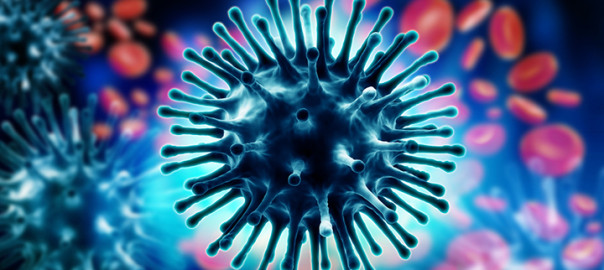Stem Cell Therapy Could Reduce Influenza-Associated Respiratory Complications

Acute lung injury (ALI) is a significant source of morbidity and mortality in critically ill patients. ALI is characterized by acute inflammation that causes disruption of the lung endothelial and epithelial barrier. ALI can be caused by infection with avian influenza virus subtype H5N1. The human mortality rate of H5N1 infection is about 60 percent. In fact, ALI is a cause of death in patients with H5N1 infections[1],[2].
In the lung, H5N1 targets alveolar epithelial cells that play important role in gas exchange. These cells also help to maintain intra-alveolar and intra-vascular fluid homeostasis by vectorial transport of sodium, chloride, and water from the apical to the basolateral surface of the alveolar epithelium (known as alveolar fluid clearance or AFC). Defective AFC and increased alveolar protein permeability (APP) promote ALI.
A study by Chan et al. shows that H5N1 releases mediators that reduce AFC and increases APP by down-regulating alveolar sodium and chloride transporter proteins. This pathology was prevented or reduced by co-culture with multipotent mesenchymal stromal cells (MSCs) in vitro and by MSC treatment in vivo in aged mice[3].
Alveolar epithelial cells (AECs) were grown with human MSCs and assayed for their ability to perform critical functions of the lung epithelium. Co-culture with MSCs led to improved ability for AECs to transport fluid from their apical to basal side and increased the barrier function of the AEC monolayer against the passage of solutes. The protective effects of MSC appear to be mediated partly by the release of soluble factors keratinocyte growth factor (KGF) and Angiopoietin1 (Ang1) by MSCs as knocking down of these proteins from MSCs using small interfering RNA (siRNA) diminished the ability of MSCs to decrease APP and increase AFC.
In aged mice infected with H5N1 virus, treatment with human MSCs enhanced survival rates and diminished the loss of body weight as a result of infection. Moreover, MSC-injected mice had improved fluid transport functions and less protein accumulation in the bronchoalveolar lavage fluid. The beneficial role of MSC intervention appeared to be effective only in aged mice (8-12 months of age). MSCs failed to improve survival in young (6–8 weeks) mice inoculated with H5N1 influenza viruses. This was also observed in previous studies [4],[5] which utilized 7-10-week-old mice and showed no improvement in response to MSC therapy.
Findings from this study suggest that MSCs may provide a therapeutic benefit to humans with severe pulmonary illness caused by influenza viruses such as H5N1, especially in older patients at higher risk of developing ALI. However, the safety of using allogeneic cells for clinical applications is currently being evaluated in several clinical trials. Allogeneic MSC therapy was found to have beneficial preclinical effects on endotoxin, bacteria, and ventilator induced acute lung injury[6],[7].
In addition to these results, more studies using MSC therapy in combination with traditional treatments of influenza infection will be useful in determining the overall impact of incorporating cell-based therapies as adjuvant treatment.
References:
[1] T. H. Tran, T. L. Nguyen, T. D. Nguyen, T. S. Luong, P. M. Pham, van V. C. Nguyen, T. S. Pham, C. D. Vo, T. Q. M. Le, T. T. Ngo, B. K. Dao, P. P. Le, T. T. Nguyen, T. L. Hoang, V. T. Cao, T. G. Le, D. T. Nguyen, H. N. Le, K. T. Nguyen, H. S. Le, V. T. Le, D. Christiane, T. T. Tran, de J. Menno, C. Schultsz, P. Cheng, W. Lim, P. Horby, and J. Farrar, “Avian influenza A (H5N1) in 10 patients in Vietnam.,” N. Engl. J. Med., vol. 350, no. 12, pp. 1179–88, Mar. 2004.
[2] K. J. Szretter, S. Gangappa, X. Lu, C. Smith, W.-J. Shieh, S. R. Zaki, S. Sambhara, T. M. Tumpey, and J. M. Katz, “Role of host cytokine responses in the pathogenesis of avian H5N1 influenza viruses in mice.,” J. Virol., vol. 81, no. 6, pp. 2736–44, Mar. 2007.
[3] M. C. W. Chan, D. I. T. Kuok, C. Y. H. Leung, K. P. Y. Hui, S. A. Valkenburg, E. H. Y. Lau, J. M. Nicholls, X. Fang, Y. Guan, J. W. Lee, R. W. Y. Chan, R. G. Webster, M. A. Matthay, and J. S. M. Peiris, “Human mesenchymal stromal cells reduce influenza A H5N1-associated acute lung injury in vitro and in vivo,” Proc. Natl. Acad. Sci., p. 201601911, Mar. 2016.
[4] I. Darwish, D. Banner, S. Mubareka, H. Kim, R. Besla, D. J. Kelvin, K. C. Kain, and W. C. Liles, “Mesenchymal stromal (stem) cell therapy fails to improve outcomes in experimental severe influenza.,” PLoS One, vol. 8, no. 8, p. e71761, Jan. 2013.
[5] J. E. Gotts, J. Abbott, and M. A. Matthay, “Influenza causes prolonged disruption of the alveolar-capillary barrier in mice unresponsive to mesenchymal stem cell therapy.,” Am. J. Physiol. Lung Cell. Mol. Physiol., vol. 307, no. 5, pp. L395–406, Sep. 2014.
[6] J. Walter, L. B. Ware, and M. A. Matthay, “Mesenchymal stem cells: mechanisms of potential therapeutic benefit in ARDS and sepsis.,” Lancet. Respir. Med., vol. 2, no. 12, pp. 1016–26, Dec. 2014.
[7] J. W. Lee, X. Fang, N. Gupta, V. Serikov, and M. A. Matthay, “Allogeneic human mesenchymal stem cells for treatment of E. coli endotoxin-induced acute lung injury in the ex vivo perfused human lung.,” Proc. Natl. Acad. Sci. U. S. A., vol. 106, no. 38, pp. 16357–62, Sep. 2009.
Image courtesy of http://www.lifeextension.com/


